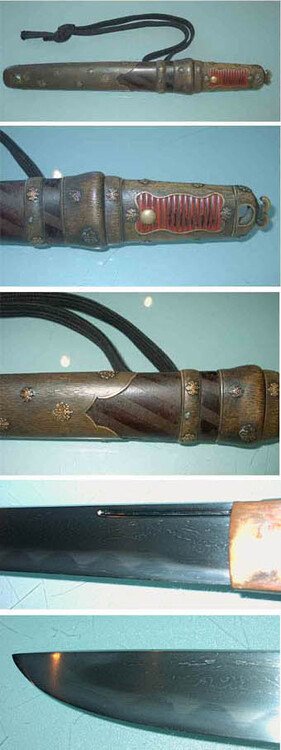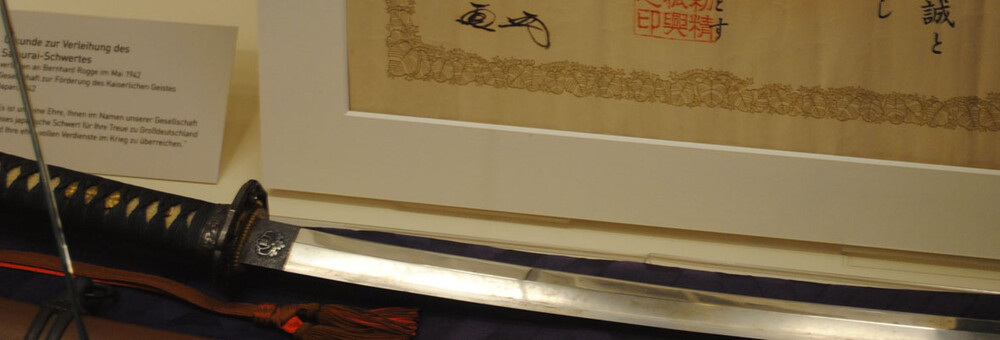-
Posts
341 -
Joined
-
Last visited
-
Days Won
2
Everything posted by leo
-
Patrick, there is an oshigata on p. 482 in the Toko Taikan, though a bit tiny to read! Martin
-
Could be: 備州長船住助定 There are 3 or 4 smiths. Martin
-
Jeremy, as Moriyama San pointed out, they have basically an online business. Still I am surprised that they did not answer your mail concerning a purchase. The owner is Masayuki Hirako. I had some business in the past with him and there always was fluent conversation in English. Off course I do not know if he is the one who speaks English or if he has somebody translating for him. So just try again! Martin
-
Here is a site with a few hundred examples: http://www.artelino.com/archive/artist_ ... 20artelino According to this Toshikata Mizuno usually signed with Oju Toshikata or Oju Toshikata-e or Oju Toshikata ga Regards, Martin
-

Translation of Mei for Nihonto and Tsuba please?
leo replied to CurtisR's topic in Translation Assistance
Hi, the name of the smith seems to be Hagashiyama Yoshihira. What makes you think it is a scam? If you really think so, simply give the name of the seller and plenty of decent people from Poland and elsewhere could tell you wether or not they had bad experience with this seller. Regards -
Dear Jason, several years ago I owned this kwaiken which is the same style of mounting. It contained a 14cm koto style unsigned blade but t as far as I can remember, the nakago looked Shinto to me. I kept no picture of it. The metal parts looked stamped, like late shiriimono kozuka, but still it fetched a good price. Apparently there are collectors around for unusual export swords if they look nice. Regards, Martin
-
Hello, Milica, This customs duty seems quite outrageous! Where do you live?
-
Koichi-San, thank you very much for the translation! Chris, I am not very familiar with showa smiths. So there is no reason to doubt your opinion. I understood you were not completely sure about his identity so I wanted to supply some more information. If I can spare me the trouble, the better! Gentlemen, thank you very much for your opinions and your help. I will let the museum guys know about this! Regards,
-
Chris, you are right, the sword in question comes with regular koshirae and the habaki carries something like a kiri-mon! Maybe more photos can clarify the question of the smith! Brian, the ivory mounted sword has its own blade. The museum is presently working on its inventory of samurai things , so it happened to be on the photo! My mistake! But I looked at it again and it is indeed a good quality carving! I will try to get additional pictures. Happy Easter!
-
Brian, you have a point there! Maybe the picture was taken befoe putting it into the tsuka ! No, seriously, then the only alternative would be kinzogan mei and filing the yasurime on later, which would rally be a bad sign!
-
Thank you very much, Chris, I`ll pass this on. Brian, this sword came with nicely carved ivory mounts, which look like the typical better quality tourist koshirae made for export! Actually has the nakago been stuck within this hilt since the museum received the legacy in the 1980s and was not removed until recently! Hopefully I will receive better pictures of blade and koshirae next week!
-
Brian, this is exactly the craftsmanship which is at the moment still a mystery to me. i know that the leaf is "sucked" onto the surface by a very thin water based adhesive medium. The art is to out the leaf and place it imediately to the final position. If you trry to move it like a decal, it will crumble into powder. I have just heard that there is a company, presumably in Japan, who laser-cuts goldleaf decals in any size from a simple .jpg-image. If you have a sequence of Kanji (mirrored!) on a paper and apply the contact medium to the iron surface, it should be possible to achieve the effect as seen. Still it would reqire a lot of skill!
-
Gabriele, this is not painted, but applied with leafgold which is so thin that it even shows the yasurime after being glued on. I have seen quite a few works recently involving this technique! There must be a few very cunning artists in Japan who are able to apply leafgold designs and also kanji to antique objects of art in order to increase the value. This is used in particular on iron tsuba. As I use leafgold for restoration of wooden furniture, I know how difficult this is. Whether right or wrong - the workmanship on this nakago is excellent!
-
Oh, and on the label it says the document was issued on April, 1942!
-
Hi, all! A friend asked me to assist in the identification of a swordsmith and the translation of a document which accompaniies the blade. He would like to pass any information on to the International Maritime Museum in the German city of Hamburg, where this sword is permanently stored. This sword was donated by the Japanese to Bernhard Rogge for military merits. He gained legendary fame as th commander of the auxiliary cruiser "Atlantis" during WWII. After the war he started a new career with the German Navy until he quit as a rear admiral. he passed away in 1982. http://en.wikipedia.org/wiki/Bernhard_Rogge He is a legend with the citizens of Hamburg, too. When in 1962 the big storm-flood occurred(a kind of tsunami caused by extreme winds), he immediately called his troops to build barriers against the flood, wthout waiting for authorization by the parliament, thus probably saving a lot of lives! I include the few pictures available to me. The nakago was, after some effort, removed from its carved ivory hilt, revealing the mei KANEKUNI SAKU! Presently I am waiting for more pictures but at the moment these are all I have. I do not know if it is dated! It is apparently a showa time blade. Can anybody tell me which of the several Kanekunis I have spotted this could be? The document says something about a "Society for the Promotion of the Imperial Spirit" Can somebody translate the document completely? Many thanks in advance, Martin
-
Thanks, Grey, helpful add on. Obviously misspelled vise, too! Martin
-
Hi, Patrick, if you can put your hands on a stable vice screwed safely to a workbench, you can remove the tsuka in no time! I have used this simple method for 30 years to take off plenty of jammed handles without damaging mounts or the polish of the blade! Take a stack of paper, say about 25 and fold them like an U. Insert the blade 10 inches below the habaki, cutting edge down, into this U and place paper and blade within the vice with shinogi in the middle! Do this carefully to avoid any direct contact between blade and vice! Cose the vice tightly! Rather use more paper if it makes you feel better! The blade must never move in order to avoid scratches! Now take a small hammer and a slab of wood and place this wood against the fuchi close to the tang with a thick piece of leather to cushion it. The elegantly curved shitogi fuchi might be more sensible than a regular one so take care not to dent it! Remove the tsuka with a few short dry hits on the wood with the hammer! Hit the fuchi alternately on either side if necessary! Regards, Martin
-
Hello to all! Recently I found a nice shinto wakizashi also with a very fine double dragon horimono, but both dragons on one side, facing each other!! On the other side there is just a bonji. Is there any meaniing to it or is it simply the fancy of the person who ordered it? Thank you in advance for any comments,
-

shipping swords from japan
leo replied to peterqu's topic in Sword Shows, Events, Community News and Legislation Issues
Once in a while I have to send a large shipment of blades to Japan for restoration works and papering. These parcels usually represent a considerable value and I hate to take a risk, especially if customer swords are involved. As I do not know a fine art shipper in Germany, I handle it this way: There are a couple of large insurance companies who do transport insurance for antiques, jewelry etc. They charge between 1 and 1,5% of the insured value. You just send a fax with the date of dispatch, the contents and the value and they fax a cofirmation back to you. You can then pick an inexpensive air carrier like DHL and send it uninsured. Also you declare whatever suits you because insurance coverage is on your side! Tell them its machine parts or your grand grand ma´s chastity belt! Interesting thing is, it also works on the way back from Japan! Same procedure. The thing with large carriers is that they do not have an insurance at all or have their own insurance firm! They simply take the high insurance fees from the customer and in case off loss, pay it from their own pocket(if they pay). They make a lot more money that way. So you know why they try to avoid compensation in case of loss by all possible means(and usually find some excuse in their transport regulations!). If I have a law suit wth an insurance company for compensation, I prefer it to be in my own country! Regards to all, Martin -
The oversized nakago(even for a nodachi) makes me think this was intended for real use, not for exhibition in a shrine. A sword of this size can only be used as a nagamaki anyway, maybe by a kind of huge Muromachi Benkei? Happy New Year to All! Martin
-
Nice work, Dirk! I include indices for Jukken and for Osafune Choshi Token Hen as .pdf. For anyone interested I can mail it as .xls or .doc index osafune choshi token hen.pdf index jukken.pdf
-

Shipping Swords from Japan to the US
leo replied to cabowen's topic in General Nihonto Related Discussion
Last week 2 Swords were sent to me from Japan by EMS to Germany. As usual EMS does this only if it is a non- stop flight. I do not know though, if this applies to the US as well. Regards, Martin -
Hi, Grey, your idea sounded great to me, so I tried it with a very small book : "Jukken(Nihon Koto Meisakushu)" Its not a big opus, but if anybody wants it, I can mail it as a word.doc. Regards, Martin
-
Hi, if I read the measurements correctly, it looks like 83cm overall length, which would leave about 68cm nagasa, i. e. katana? Regards, Martin
-
Interesting information you have there about the fate of the later generation Kunikane blades, Peter. Any literature about this you can recommend? Greetings, Martin









